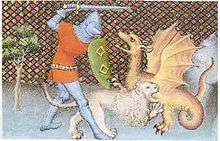Yvain, the Knight of the Lion
Yvain, the Knight of the Lion (French: Yvain ou le Chevalier au Lion) is an Arthurian romance by French poet Chrétien de Troyes. It was probably written in the 1170s simultaneously with Lancelot, the Knight of the Cart, and includes several references to the narrative of that poem.
It is a story of knight-errantry, in which the protagonist Yvain is first rejected by his lady for breaking a promise, and subsequently performs a number of heroic deeds in order to regain her favor.
Summary

In the narrative, Yvain seeks to avenge his cousin Calogrenant who had been defeated by an otherworldly knight Esclados beside a magical storm-making stone in the forest of Brocéliande. Yvain defeats Esclados and falls in love with his widow Laudine. With the aid of Laudine's servant Lunete, Yvain wins his lady and marries her, but Gawain convinces him to leave Laudine behind to embark on chivalric adventure. Laudine assents but demands he return after one year. Yvain becomes so enthralled in his knightly exploits that he forgets to return to his wife within the allotted time, so she rejects him. Yvain goes mad with grief, is cured by a noblewoman, and decides to rediscover himself and find a way to win back Laudine. A lion he rescues from a dragon[1] proves to be a loyal companion and a symbol of knightly virtue, and helps him defeat both a mighty giant and three fierce knights. After Yvain rescues Lunete from being burned at the stake, she helps Yvain win back his wife, who allows him to return, along with his lion.
Sources and reception
Chrétien's source for the poem is unknown, but the story bears a number of similarities to the hagiographical Life of Saint Mungo (also known as Saint Kentigern), which claims Owain mab Urien as the father of the saint by Denw, daughter of Lot of Lothian.[2] The Life was written by Jocelyn of Furness in ca. 1185, and is thus slightly younger than Chrétien's text, but not influenced by it. Jocelyn states that he rewrote the 'life' from an earlier Glasgow legend and an old Gaelic document, so that some elements of the story may originate in a British tradition. The name of the main character Yvain, at least, ultimately harks back to the name of the historical Owain mab Urien (fl. 6th century).
Yvain survives in eight manuscripts and two fragments. It comprises 6,808 octosyllables in rhymed couplets. Two manuscripts are illustrated, Paris BN MS fr. 1433 and Princeton University Library Garrett MS 125 (ca. 1295), the former incomplete with seven remaining miniatures and the latter with ten. Hindman (1994) discusses these illustrations as reflecting the development of the role of the knight, or the youthful knight-errant, during the transitional period from the high to the late medieval period.[3]
Yvain had a huge impact on the literary world; German poet Hartmann von Aue used it as the basis for his masterpiece Ywein, and the author of Owain, or the Lady of the Fountain, one of the Welsh Romances included in the Mabinogion, recast the work back into its Welsh setting. The poem was also translated into a number of other languages, including the Middle English Ywain and Gawain; the Old Norwegian Ívens saga and the Old Swedish Herr Ivan.
The Valþjófsstaður door in Iceland, ca. 1200, depicts a version of the Yvain story with a carving of a knight slaying a dragon that threatens a lion. The lion is later shown wearing a rich collar and following the knight, and later still the lion appears to be lying on the grave of the knight.
The first modern edition was published in 1887 by Wendelin Foerster.
Notes
- ↑ de Troyes, Chretien (1991). Arthurian Romances (First ed.). London: Penguin Classics. p. 337. ISBN 0140445218.
- ↑ Duggan, Joseph J. (1987). In Chrétien de Troyes; Burton Raffel, Yvain, the Knight of the Lion, pp. 214–216. Yale University Press.
- ↑ Hindman, Sandra. Sealed in Parchment. Rereadings of Knighthood in the Illuminated Manuscripts of Chretien de Troyes. University of Chicago Press, 1994. $16.95 (pb). ISBN ISBN 0-226-34156-9, review by M. McIlwain: "She uses the motif of the knight, the profession common to all of Chretien's protagonists, to track this change. In each of five chapters she considers how distinct social identities for the knight seem to have dominated the way in which individual texts of Chretien's poems were illustrated, read, and understood."
References
- Chrétien de Troyes; Owen, D. D. R. (translator) (1988). Arthurian Romances. New York: Everyman's Library. ISBN 0-460-87389-X.
- Chrétien de Troyes; Raffel, Burton (translator) (1987). Yvain, the Knight of the Lion. Yale University Press. ISBN 0-300-03837-2.
- Lacy, Norris J. (1991). "Chrétien de Troyes". In Norris J. Lacy, The New Arthurian Encyclopedia, pp. 88–91. New York: Garland. ISBN 0-8240-4377-4.
External links
| Wikisource has original text related to this article: |
- Four Arthurian Romances by Chrétien de Troyes' at Project Gutenberg (includes Yvain)
- Medieval and Renaissance Manuscripts at Princeton University Library (page has a links to a pdf file of a facsimile of Garrett MS 125)
- Yvain, the Knight of the Lion in a freely-distributable PDF document
-
 Yvain, or the Knight with the Lion public domain audiobook at LibriVox
Yvain, or the Knight with the Lion public domain audiobook at LibriVox